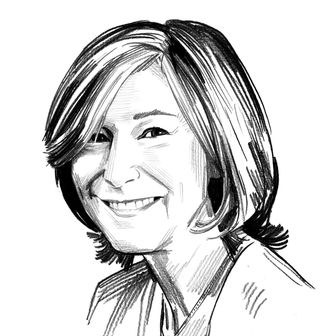
Q: I’m 64 and trying really hard not to succumb to most of the anti-aging “fixes.” But I’ve been getting Botox for my frown lines. And now I’m unhappy with the saggy skin on my cheeks (photo enclosed). What do you think about facial thread lifts? Are they safe? Effective?
A: Thank you for sending a photo. Hard as I scrutinized it, I could not find any saggy skin on your cheeks. So here is a reminder that no one sees you with the intense critical eye you see yourself.
I’ve watched a few YouTube videos of doctors doing various kinds of thread lifts, and I have to tell you that though they’re sometimes referred to as a “quick fix,” they’re not the kind of quick fix I, myself, would succumb to. The idea of erecting a suspension bridge under my face is too much for the chickenhearted engineer in me.
But you may be far more intrepid than I. So I emailed HNTFUYF DermDiva, Heidi Waldorf, M.D., for her considered opinion. She filled us in on everything you might want to know about a thread lift.
First things first:“You have to define what you mean by ‘thread lift,’” she said.
“In general, a thread lift is a set of suspension sutures (threads) used to shift placement of the skin. There are different types of threads: permanent; absorbable; with cone or hook-shaped anchors; and others made of various materials.
The permanent (non-absorbable) threads hold the treated area in place by remaining immovable. According to studies, absorbable threads generally stimulate collagen formation (biostimulation) to help maintain the skin position as the suture disappears. The amount of time the lifting effect lasts ranges from six months to two years, depending on the kind of suture and anchoring material, how many are used, and the degree of aging’s effects on the patient’s skin.
It’s important to understand that a thread lift does not yield the results of a face- lift, cautioned Waldorf. It’s used to reposition the skin (repositioning muscle is not involved) and to act, via biostimulation, like linear filler.
Wait, linear filler?
“In other words, the threads create new collagen only along their path to hold the skin’s repositioning, but don’t create volume the way an injectable filler does. So facial proportions are improved without the face getting bigger,” said Waldorf. For best results, a thread lift is frequently combined with a skin-tightening procedure and injectables, she added.
Waldorf uses Silhouette Instalift (called Silhouette Soft outside the U.S.) because it anchors the skin in two directions rather than the standard one, she said. It’s an absorbable thread with some of the same material that Sculptra is made of.
The vector lines in the direction the physician wants to shift and lift are marked with pencil while the patient is sitting up, before the procedure begins; the lines, from cheek to jowl, may be different on each side. (Our faces are not perfectly symmetrical.) The number of threads used depends on the amount of pull needed, she said.
What happens next sounds just like taking your face to the tailor. After an injection of local anesthesia, an entry point in the center of a vector is made, said Waldorf. The thread is inserted there — pretty much in the way you’d pull a thread through a piece of fabric to make a large stitch — and exits at the lower end of the vector. The other end of the needle goes in the same center entrance, and the physician pulls the rest of the thread out the higher end. (In one end and out the other. On your face.) On average, Waldorf said she uses four threads per side. Then comes the part that does the lifting. (Also, the part that does for me the freaking out.) Waldorf pushes the skin over each suture until it catches. The skin initially may look bunched, but that resolves in a few days to two weeks, said Waldorf. Average cost of the procedure: anywhere from $1,800 to $4,500.
You might care to know there is another kind of thread procedure that involves fewer needles and less pulling. Unidirectional barbed absorbable polydioxanone (PDO) threads are popular because they’re quicker to place and have less downtime. With barbs facing in only one direction, the threads are inserted within a hollow cannula or needle that is then withdrawn. The procedure is quicker with less discomfort, but more threads are required to achieve a lift and the results are shorter lived (one to two years, in general). These threads work by stimulating fibrosis, a tissue reaction that encourages the growth of collagen. They work better for younger patients with less skin laxity looking for a minimal tightening effect.
If your skin is thin, whether from age or genetics, a thread lift won’t be in your future: The skin needs to be dense enough to keep the thread from being visible, said Waldorf. So, dear reader, at 64, a thread lift may not be for you. And it’s worth another reminder that, in spite of the prevalence of what many in the business of aesthetics call the “non-surgical face-lift,” if you’re looking for the effect of a face-lift, the only way you can be sure to get it is with … a face-lift.
More From This Series
- I’m 60 and My Retinol-Based Routine Stopped Working. What Do I Do?
- I Can’t Take My Eyes Off Donatella Versace’s New Look


